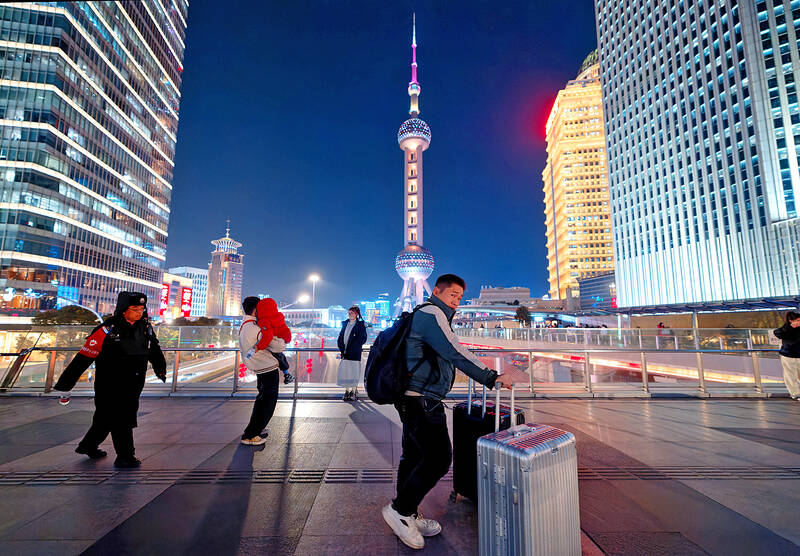China’s economy hit the government’s growth goal last year after an 11th-hour stimulus blitz and export boom turbocharged activity, although looming US tariffs threaten to take away a key driver of expansion.
GDP rose 5 percent in the world’s second-largest economy, data released by the Chinese National Bureau of Statistics yesterday showed, slightly exceeding the median estimate of 4.9 percent in a Bloomberg survey.
“The biggest bright spot in the economy last year was exports, which was very strong, especially if price factor was excluded,” BNP Paribas SA chief China economist Jacqueline Rong (榮靜) said. “That means the biggest problem this year will be US tariffs.”

Photo: EPA-EFE
China has vowed further monetary easing and stronger public spending this year, as its economy braces for US president-elect Donald Trump’s return to the White House.
Trump has threatened tariffs of as high as 60 percent on Chinese goods, which could decimate trade with the Asian country.
Those very threats encouraged global businesses to frontload shipments and bolstered growth last year. However, that boost might fade in the coming months, as potential levies, including from the EU and other trade partners, make Chinese exports less competitive.
The yuan strengthened 0.1 percent against the US dollar in onshore and offshore markets after the data release. The benchmark CSI 300 index of Chinese stocks erased an earlier loss of 0.5 percent to rise 0.5 percent.
“The government has repeatedly alluded to significant support. We see this forthcoming, as Friday’s data hammer home the pressing need. The imperative could become even greater in the case of higher tariffs hitting exports significantly,” Bloomberg economists Chang Shu and David Qu (曲天石) said.
While China’s nearly flawless record in reaching its headline growth target is frequently doubted, the broad set of data also suggests Beijing’s policy pivot since late September last year helped counter headwinds from a years-long property slump and entrenched deflation.
Industrial production beat estimates to rise 6.2 percent last month compared with the previous year, the fastest pace since April last year.
The picture for domestic demand is more mixed. While unemployment climbed for the first time since August last year and property sales continued to contract, consumption showed signs of an uptick in categories helped by the stimulus push.
Retail sales rose 3.8 percent in the last quarter, accelerating to the fastest pace last year after the government ramped up a program to subsidize purchases of appliances, cars and business equipment. That brought home goods sales growth to 12.3 percent, the highest since 2013.
“Front-loaded export orders certainly helped, but the improvement was not just seen in exports, but also in consumption, which was largely a result of purchase subsidies,” Macquarie Group Ltd China economics head Larry Hu (胡偉俊) said.
Economists led by Robin Xing (邢自强) at Morgan Stanley estimate that about 60 percent of the rebound in annual growth was caused by China’s policy to boost consumption and manufacturing investment, while the rest came from advanced shipments.

RUN IT BACK: A succesful first project working with hyperscalers to design chips encouraged MediaTek to start a second project, aiming to hit stride in 2028 MediaTek Inc (聯發科), the world’s biggest smartphone chip supplier, yesterday said it is engaging a second hyperscaler to help design artificial intelligence (AI) accelerators used in data centers following a similar project expected to generate revenue streams soon. The first AI accelerator project is to bring in US$1 billion revenue next year and several billion US dollars more in 2027, MediaTek chief executive officer Rick Tsai (蔡力行) told a virtual investor conference yesterday. The second AI accelerator project is expected to contribute to revenue beginning in 2028, Tsai said. MediaTek yesterday raised its revenue forecast for the global AI accelerator used

TEMPORARY TRUCE: China has made concessions to ease rare earth trade controls, among others, while Washington holds fire on a 100% tariff on all Chinese goods China is effectively suspending implementation of additional export controls on rare earth metals and terminating investigations targeting US companies in the semiconductor supply chain, the White House announced. The White House on Saturday issued a fact sheet outlining some details of the trade pact agreed to earlier in the week by US President Donald Trump and Chinese President Xi Jinping (習近平) that aimed to ease tensions between the world’s two largest economies. Under the deal, China is to issue general licenses valid for exports of rare earths, gallium, germanium, antimony and graphite “for the benefit of US end users and their suppliers

Dutch chipmaker Nexperia BV’s China unit yesterday said that it had established sufficient inventories of finished goods and works-in-progress, and that its supply chain remained secure and stable after its parent halted wafer supplies. The Dutch company suspended supplies of wafers to its Chinese assembly plant a week ago, calling it “a direct consequence of the local management’s recent failure to comply with the agreed contractual payment terms,” Reuters reported on Friday last week. Its China unit called Nexperia’s suspension “unilateral” and “extremely irresponsible,” adding that the Dutch parent’s claim about contractual payment was “misleading and highly deceptive,” according to a statement

Artificial intelligence (AI) giant Nvidia Corp’s most advanced chips would be reserved for US companies and kept out of China and other countries, US President Donald Trump said. During an interview that aired on Sunday on CBS’ 60 Minutes program and in comments to reporters aboard Air Force One, Trump said only US customers should have access to the top-end Blackwell chips offered by Nvidia, the world’s most valuable company by market capitalization. “The most advanced, we will not let anybody have them other than the United States,” he told CBS, echoing remarks made earlier to reporters as he returned to Washington